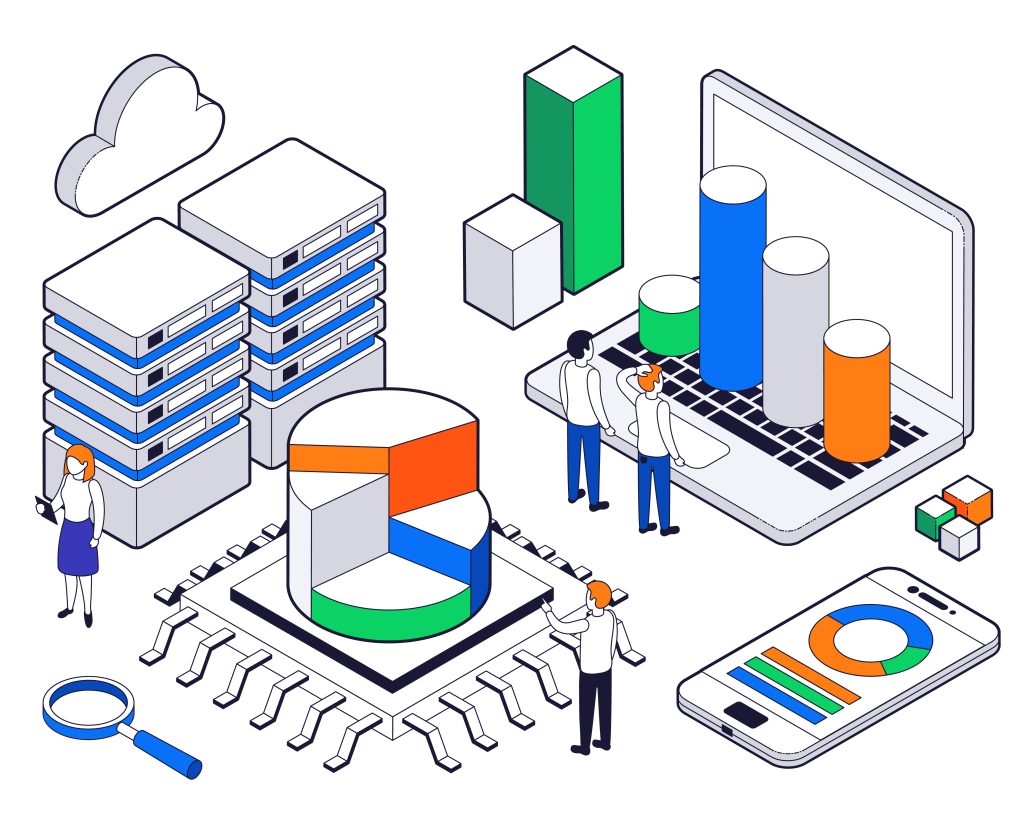Google Cloud Platform with Data Analytics
Google Cloud Analytics
Data is paramount in fast-paced technical era. Every click, every interaction, every purchase holds valuable insights waiting to be discovered. And with Google Cloud Analytics, tapping into this goldmine of information has never been easier or more rewarding.
Imagine having the ability to peer into the hearts and minds of your customers, understanding their preferences, anticipating their needs, and delivering personalized experiences that leave them coming back for more. That’s the power of Google Cloud Analytics at your fingertips. At the core of this transformative suite of services lies Google Analytics, your gateway to a wealth of data on website traffic, user behavior, and sales performance. But it doesn’t stop there. With Google BigQuery, you can dive deep into your data, asking complex questions and uncovering hidden patterns that hold the key to unlocking growth opportunities.
Big data architecture in Google cloud Platform
Avoiding data swamps is the main goal of this architecture With the help of big data architectures, organizations may store enormous volumes of structured and unstructured data while keeping metadata and other features that facilitate quick searching and analysis.

Data Ingestion with big data architecture in Google cloud Platform
In datalake we ingest the data from the different sources and of different types like OLTP, through internet of things(IOT),it get supported by the google cloud storage API so that the google cloud storage can be linked through the other pipelines. Opening up a world of limitless opportunities powered by data is what Google Cloud Platform (GCP) is like. It’s the skill of assiduously compiling data from many sources and integrating it into the GCP environment for investigation and evaluation. Imagine logs, clickstreams, and real-time data streams all seamlessly merging into Google Cloud Pub/Sub, a dynamic messaging service that manages this informational symphony. Before data travels across the cloud, Google Cloud Storage is prepared like a trustworthy safe, accepting all kinds of data. With the help of Apache Beam, Google Cloud Dataflow assumes control once users are inside and uses its unsurpassed efficiency to orchestrate data flow in batch processing or real-time streams. Moreover, when it’s
Processing in GCP Big data architecture
In the field of data analytics, careful preparation and strategic judgments pave the way from unprocessed data to useful insights. Making data easily accessible for analysis is a critical next step after it has been consumed and safely stored. Welcome to the world of targeted data marts. Within an organization, these specialized repositories include subsets of data that have been carefully selected to fulfill the specific requirements of different business units or analytical tasks. Their well-structured schema, which was painstakingly created to expedite access to vital information and simplify querying, is the secret to their efficacy. Organizations can streamline the analytical process and enable users with quick and easy access to the data they need for well-informed decision-making by immediately arranging data in this way upon intake.

Design and deployment in Google Cloud Platform
Putting in place orchestrated data pipelines is essential to guarantee the timeliness and relevancy of data marts. Utilizing the analytics workflows provided by Google Cloud provides a solid foundation for effective data processing and analysis. Through the seamless integration of SQL capabilities in BigQuery with extract, transform, and load (ETL) procedures, companies can effortlessly ingest raw data and convert it into a format appropriate for consumption downstream. Furthermore, processing and storing transformed data in Cloud Storage is made possible by leveraging Hadoop for batch analytics via the Google Cloud Data process, which makes it easier to do sophisticated analytics operations with Spark SQL and Hive. Big Query’s streaming features, in conjunction with Dataflow and Pub/Sub, enable the development of SQL-based pipelines for real-time data processing, delivering instantaneous insights and facilitating continuous monitoring.
Data cloud analytics solutions and services in GCP
Big Query
BigQuery is a fully managed, serverless data warehouse that enables scalable analysis over petabytes of data.
- BigQuery ML: Seamlessly build and deploy machine learning models using SQL within BigQuery. No need for separate tools or environments.
- BigQuery BI Engine: Experience lightning-fast, in-memory analysis with sub-second response times, empowering real-time decision-making.
- Connected Sheets: Analyze massive datasets effortlessly in Google Sheets using familiar tools like charts and pivot tables, no SQL required.
- Data QnA: Ask questions in natural language and unlock petabyte-scale insights instantly. Perfect for teams with varying technical skills.
- BigQuery Omni: Analyze data across multiple cloud platforms effortlessly. One interface, endless possibilities.
Dataflow
Enter Dataflow, Google Cloud’s game-changing streaming analysis service designed to revolutionize how organizations process and leverage their data in real-time.

Streamlined Performance with Streaming Engine in dataflow
Dataflow’s Streaming Engine is the backbone of real-time analytics, ensuring that data latency becomes a thing of the past. By separating compute from state storage, Dataflow optimizes pipeline execution, delivering lightning-fast processing speeds and dynamic autoscaling. Say goodbye to bottlenecks and hello to seamless performance, regardless of data volume or complexity.
Effortless Visualization with Dataflow SQL in dataflow
Empowering users with the ability to transform data into actionable insights has never been easier, thanks to Dataflow SQL. This innovative feature allows businesses to harness the power of familiar tools like Google Sheets and other BI solutions to create real-time dashboards. Say goodbye to complex coding – with Dataflow SQL, rapid visualization is just a few clicks away.
Optimize Resource Allocation with Autoscaling in dataflow
Dataflow’s Autoscaling feature takes the guesswork out of resource allocation, automatically adjusting the number of worker instances based on workload demands. By optimizing costs and processing time, businesses can focus on what matters most – analysis. With Autoscaling, infrastructure management becomes a thing of the past, allowing organizations to unlock the true potential of their data.
Experience the Future of Data Analytics in dataflow
With Dataflow, the future of data analytics is here, and it’s brighter than ever. Say hello to real-time insights, actionable intelligence, and unparalleled performance. Join the countless businesses already reaping the benefits of Dataflow and take your data analysis to new heights.
Data prep
Easy Data Preparation, Cleaning, and Exploration: Handle data without coding using our intuitive interface.
Versatile Applications: Data prep enables a variety of use cases, from powering machine learning to visualizing reports.
Scalable & Serverless: Set aside concerns about infrastructure; Data prep is completely serverless and expandable.
Predictive Transformations: To save time and effort, intelligent predictions recommend changes for every input.
No Coding Necessary: Prepare data seamlessly without writing a single line of code.
Manage both structured and unstructured data with ease on a single platform with the help of unified data experience.
Data Proc
Dataproc service makes deployments of Apache Spark and Hadoop clusters easier by offering fully managed cloud services. You may use Dataproc to optimize your clusters, save expenses, and guarantee high availability by selecting the necessary resources for each cluster node and utilizing autoscaling.
Fully Managed Service: Say goodbye to the complexities of cluster provisioning, configuration, and maintenance. With Dataproc, Google Cloud takes care of the heavy lifting, allowing you to focus on deriving insights from your data rather than managing infrastructure.
Tailored Resource Customization: Every workload is unique, and Dataproc recognizes that. With the ability to customize compute and memory resources for each cluster node, you can fine-tune your environment to match specific workload requirements, ensuring optimal performance and cost efficiency.
Dynamic Autoscaling: Experience unprecedented flexibility with Dataproc’s autoscaling capabilities. Whether your workload fluctuates throughout the day or experiences sudden spikes in demand, Dataproc automatically adjusts the cluster size to match workload needs, optimizing resource utilization and minimizing costs.
Cost Optimization at its Finest: Say goodbye to over-provisioning and unnecessary expenses. Dataproc empowers you to optimize costs by scaling resources up or down on-demand, ensuring that you only pay for what you use. With Dataproc, cost efficiency is not just a goal—it’s a reality.
Unrivaled High Availability: Downtime is not an option in today’s fast-paced digital landscape. Dataproc offers built-in high availability features that guarantee your clusters remain accessible and operational at all times. From node failures to unexpected disruptions, Dataproc handles it all seamlessly, ensuring uninterrupted data processing.
Seamless Integration with GCP Services: Dataproc is more than just a standalone solution—it’s a cornerstone of your end-to-end data processing ecosystem. Leveraging seamless integration with Google Cloud services such as BigQuery, Cloud Storage, and Dataflow, Dataproc enables you to build robust data pipelines and analytics solutions effortlessly.
Stream analytics
Empower Your Decisions with Efficient Processing at Scale
In the world of stream analytics, speed is of the essence. Google Cloud’s powerful processing tools enable you to handle hundreds of millions of events per second with ease, providing you with lightning-fast insights without compromising on accuracy or reliability.
Stay Ahead of the Curve with Actionable Insights in Real Time
In today’s dynamic business environment, every second counts. With Google Cloud’s stream analytics solutions, you can derive actionable insights from streaming data instantaneously, allowing you to respond to emerging trends, identify anomalies, and seize opportunities the moment they arise.
Let’s understand it with a scenario
Revolutionizing Operations with Google Cloud Platform Company XYZ, a burgeoning e-commerce enterprise, grapples with scalability issues on their legacy infrastructure. Opting for a transformation, they turn to Google Cloud Platform (GCP) to unlock unparalleled growth potential.
Evaluation and Strategy: XYZ collaborates with GCP specialists, devising a migration strategy tailored to their needs, ensuring a smooth transition to the cloud. Migration and Integration: Leveraging GCP’s migration tools, XYZ seamlessly moves their applications and data, integrating them into the robust GCP ecosystem. Scalability and Reliability: GCP’s elastic infrastructure empowers XYZ to effortlessly scale resources, ensuring uninterrupted performance even during peak demand periods. Advanced Analytics and AI: With GCP’s advanced analytics and AI capabilities, XYZ gains actionable insights into customer behavior, fueling data-driven decisions and personalized experience
Furthermore, GCP’s pay-as-you-go model enables XYZ to optimize costs by eliminating inefficiencies and maximizing resource utilization. Encouraged by GCP’s commitment to innovation, XYZ explores cutting-edge technologies such as machine learning to revolutionize operations and elevate customer engagement. With the support of GCP’s global network, XYZ embarks on a journey of global expansion, effortlessly reaching customers across the globe with unparalleled speed and reliability. Through this transformative alliance, Company XYZ not only achieves unprecedented agility, efficiency, and innovation but also establishes itself as a trailblazer in the dynamic e-commerce industry.
Here is the link to my previous blog – Using LWR to Build Custom Pages in Salesforce








